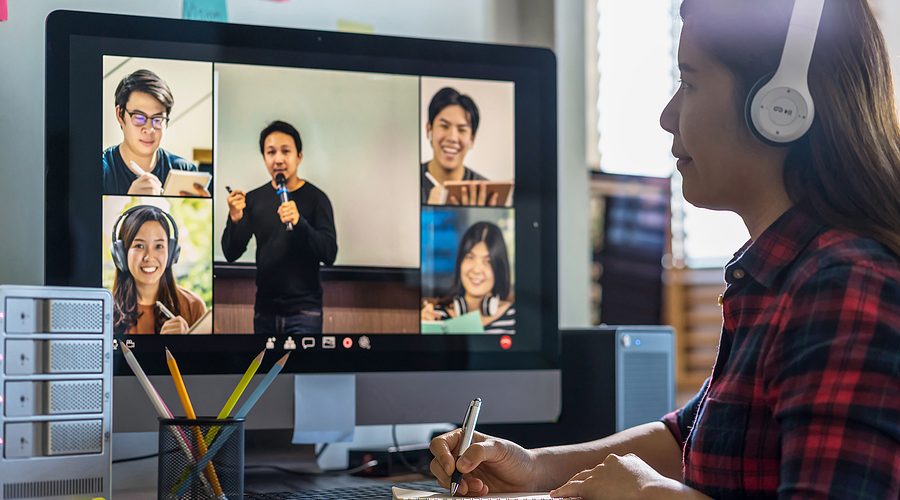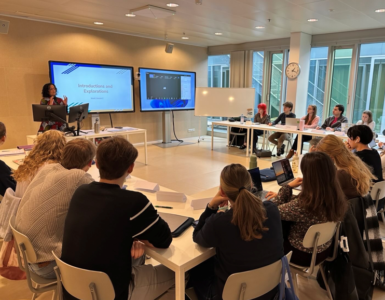The “new normal” of Covid has required a lot of changes to the college experience in the United States, and that includes the widespread use of video conferencing tools (Zoom, Google Meetings, etc.) to conduct online classes in real time. The extent to which this is happening varies widely, though there are universities and colleges requiring instructors to conduct their previously scheduled face to face classes in real time with synchronous video software. This “all Zoom, all the time” approach to online teaching is even more common in elementary and secondary schools.
The conventional wisdom and most common approach for teaching online courses is asynchronous to allow students to engage in the course at different times and days to take advantage of the affordances of the medium. So as someone who has been teaching asynchronously online since 2005 and who has been researching and writing about distance education for some time, I find this use of synchronous video for online teaching puzzling. To illustrate this point, let me offer a thought experiment:
Suppose I was scheduled to teach a “traditional” asynchronous course and for some reason, it was suddenly rescheduled into a traditional face to face class, something that meets Tuesdays and Thursdays from 10 am to 11:45 am. This sudden change is incredibly disruptive because I had already planned everything to be online. So suppose I decide to soldier on and teach the class as if it were still an asynchronous online class. Everyone has to physically show up to the class at the scheduled time (I have no choice about that), but beyond that, everything was online. Other than some small talk at the beginning and end of the class, I’d allow no conversation or even acknowledgement that we were sitting in the same room. Students would only interact with each other in the class Learning Management System. Students would sit at their desks for 75 minutes, silently working and never looking up from their computers, and as the instructor, I would sit in the front of the room and do the same. We’d repeat this at all meetings for the entire semester.
Ridiculous, right? And yet this is essentially what an online Zoom class looks like to me. It’s forcing a pedagogy that works best in face to face settings into the online classroom, forcing a square peg into a round hole.
Even worse, synchronous video is enabling an alarming amount of policing and surveillance of both teachers and students. Both Inside Higher Ed and the Chronicle of Higher Education published inadvertently hilarious op-eds written instructing faculty about how they should maintain their own appearances and of their “Zoom backgrounds” to project professionalism and respect. Some teachers– especially at the elementary and secondary levels– insist on rules to regulate their students’ dress and appearance down to requiring students wear shoes. And unbeknownst to many faculty who themselves use Zoom and other tools to surveil their students in their own homes, one of the “features” of synchronous video tools is they provide robust usage data to administrators. In other words, professors might be using Zoom to keep an eye on their students without realizing that their department chairs and deans might very well be using Zoom to keep an eye on them.
On the other hand, when the conventional wisdom about almost anything is put to the test, it often turns out to be wrong. Could there be something to all this Zooming after all?
In more normal times, online classes are almost always delivered asynchronously and without live video because of the flexibility the format affords students, the ease of scheduling (colleges don’t have to worry about time and place conflicts with other courses), and the technical challenges of synch video. But these previously scheduled face to face classes still have an agreed meeting time, and the expectations of the students in these classes favors at least some real-time discussion and interaction. The hardware and bandwidth requirements of synch video remains a challenge for some students working with hand-me-down laptops and sketchy wifi, but it is certainly much more feasible now than it was just a few years ago.
Given the chaos of the world we are living in right now, I wouldn’t confidently predict what anything will be like in a (hopefully) near future where Covid is under control and we can resume safely gathering in groups, including in classrooms. But I do know that after a year where we are seeing many different styles of online classes at both schools that have been offering online courses for decades and those elite universities offering a significant number of online classes for the first time, we will not be going back to the way things were. Zoom or no Zoom, the differences between fully online and fully face to face college classes is rapidly fading away.
Editor’s note: Steven will be giving a talk at our next online Media & Learning Conference on 18 November on “Scaling up and providing access to video based services in higher education” when he will also be available for discussion.

Author
Prof Steven D. Krause,
Eastern Michigan University, USA
Find out more about Steven and his work here.














